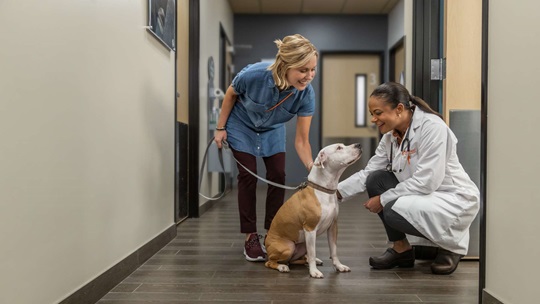Medical quality standards reduce anesthesia associated mortality in veterinary practice
As part of the quality improvement program at Banfield’s network of primary care hospitals, we focused on reducing anesthesia-related mortality in dogs and cats. We first identified systemic and local risk factors associated with anesthesia mortality. We then developed and implemented medical quality standards (MQS) to provide a structured and consistent framework around anesthesia to help mitigate these risk factors. Ongoing and robust data capture enabled us to monitor the impact of MQS on mortality.

What this means for veterinarians
It may be challenging for hospital teams to recognize the importance and population-level impact of an intervention focused on a relatively rare occurrence, such as anesthesia-related mortality.
But because this outcome is so serious, even small reductions can have enormous significance, not only for our patients, but for our hospital teams and clients.
We have shown that MQS can reduce anesthesia mortality in primary care veterinary hospitals, improving the quality of care we offer and enhancing safety. You can visit Banfield’s Anesthesia Resources website to find resources and tools designed to help you get the best results for every pet, every time.
Identifying risk factors
To inform our quality improvement effort, we needed to document the factors that increase the risk of anesthesia-related mortality. We first identified the systemic or universal risks inherent to any anesthetic procedure by reviewing the available peer-reviewed literature, professional guidelines, and position statements.
These risk factors included hypothermia, hypotension, American Society of Anesthesiologists physical status, and procedural complexity. Next, we analyzed internal medical record data, and internal safety reports to identify local risks. These are risks that depend on the individual hospital environment and veterinary medical team and include risks such as level of education and training on anesthesia monitoring.
Developing MQS to mitigate risks
We then developed MQS, standards of practice meant to mitigate the systemic and local risks associated with anesthesia in primary care practice. The MQS describe two levels of care: clinical essentials constitute the minimum acceptable level of care, and best practices exceed that minimum acceptable. All MQS are simple, declarative statements that do not remove clinical decisions from the providing team, but rather depict the overarching standards for providing anesthesia.
We obtained input on MQS from veterinarians with various roles in the organization (operations, research, quality) and from external, board-certified veterinary anesthesiologists. We grouped the MQS into five categories following the usual progression of an anesthetic event: general, equipment, preanesthetic, induction and intubation, and monitoring and recovery. We then incorporated MQS into updated anesthesia guides (Anesthesia and Analgesia for the Veterinary Practitioner, Canine and Feline).
Implementing MQS
Hospitals were notified in advance of upcoming changes to the anesthesia program to reflect MQS. We provided each hospital with an anesthesia tool kit containing hard copies of the anesthesia guides, MQS, job aids, communication guides, and supporting materials (e.g., checklist copies).
The implementation and education period lasted six months. Promoting adoption and operationalization of MQS by hospital teams required substantial time, focus, attention, and communication in addition to the tool kit materials.
During implementation, we emphasized the clinical essentials for our hospital teams. Best practices were offered as motivational and aspirational goals to work towards once clinical essentials were established. We encouraged hospital teams to educate members and incorporate MQS in ways that best aligned with their local environments and operational workflows.
The payoff: reduced mortality
During period of the study, 2,038,318 dogs and 350,410 cats underwent general anesthesia at our hospitals. Before we implemented MQS, mortality rate was already consistent with, or lower than, reports from others in the profession. Six months after implementation of MQS, mortality decreased even further, preventing at least an additional 1 death per 10,000 procedures. And as we have continued our quality focus on safe anesthesia, at the end of 2021 we recorded our lower ever anesthesia associated mortality rate.
We are proud that we have recently had this work published in the Veterinary Anesthesia and Analgesia journal. We will continue to prioritize quality and safety, remembering that quality is a journey, not a destination.
